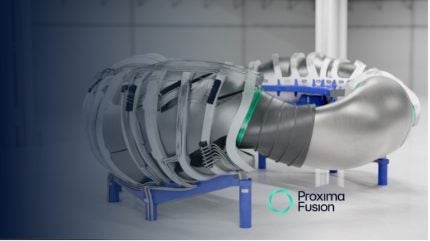
Munich-based start-up Proxima Fusion Proxima Fusion has provided design details of Stellaris, a stellarator which it said “could be delivered by the 2030s”. In April 2024, Proxima Fusion raised €20m ($21.7m) in seed funding to accelerate its plans to build the first generation of fusion power plants based on quasi-isodynamic (QI) stellarators with high-temperature superconductors.
The concept was published in Fusion Engineering and Design. Proxima added that Stellaris “builds on the record-breaking results of the Wendelstein 7-X (W7-X) research experiment in Germany, the most advanced QI stellarator prototype in the world, directed by the Max Planck Institute for Plasma Physics (IPP) and the product of over €1.3bn in funding from the German Federal Government and the European Union”.
Proxima Fusion is the first spin-out from the Max Planck Institute for Plasma Physics (IPP). The start-up was founded by former scientists and engineers from the Max Planck IPP, MIT, and Google-X. The group aims to deploy a new high-performance stellarator over the coming years. Proxima Fusion has been building on IPP’s experimental and theoretical work, with a strong engineering workforce “from the likes of Google, Tesla, McLaren Formula-1, and SpaceX”.
Dr Francesco Sciortino, Co-Founder and CEO of Proxima Fusion, said: “The path to commercial fusion power plants is now open. Stellaris is the first peer-reviewed concept for a fusion power plant that is designed to operate reliably and continuously, without the instabilities and disruptions seen in tokamaks and other approaches.”
Proxima claims that Stellaris is both smaller and more powerful than any stellarator power plant ever designed before. The much stronger magnetic fields that are enabled by high-temperature superconducting (HTS) magnet technology allow for a significant reduction in size compared with previous stellarator concepts. Smaller reactors can be built more quickly, provide more efficient energy generation, and will eventually be more cost-effective in both construction and operation. The Stellaris concept also makes use of only currently available materials, meaning it will be buildable by expanding on today’s supply chains.
Stellaris “is the first QI stellarator-based power plant design that simultaneously meets all major physics and engineering constraints, as demonstrated through electromagnetic, structural, thermal, and neutronic simulations”.
Proxima’s simulation-driven engineering approach has enabled rapid design iterations, leveraging advanced computing, the company said. “The integration of physics and engineering constraints within a single optimisation framework allows the company to now take a bold leap with its demonstration stellarator, Alpha, as opposed to building several devices with incremental improvements over a period of decades.”
Professor Dr Per Helander, Head of the Stellarator Theory Division at the Max Planck IPP, said: “IPP is a pioneer of stellarator optimization. In recent years we have been able to design stellarators whose physics properties are predicted to grant unprecedented performance. This still leaves many technological and engineering challenges, problems that have been courageously addressed by Proxima Fusion in collaboration with IPP in this first of its kind study.”
Dr Jorrit Lion, Proxima Co-Founder and Chief Scientist noted: “For the first time, we are showing that fusion power plants based on QI-HTS stellarators are possible. The Stellaris design covers an unparalleled breadth of physics and engineering analyses in one coherent design. To make fusion energy a reality, we now need to proceed to a full engineering design and continue developing enabling technologies.”
Proxima lists the following “groundbreaking technical features of the Stellaris design”:
- A magnetic field design that obeys all key physics optimization goals for energy production;
- Support structures that can bear the forces present when operating at full power;
- A showcase that HTS technology can be effectively integrated in high field stellarators, while ensuring effective heat management on internal surfaces;
- A neutron blanket concept that is adapted to the complex geometry of stellarators.
It provides an ambitious timeline. “Through its Stellarator Model Coil (SMC) demo magnet in 2027, Proxima Fusion will fully de-risk HTS technology for stellarators. The company will demonstrate that stellarators are capable of net energy production with its demo stellarator Alpha in 2031, and aims to deliver limitless, safe, clean fusion energy to the grid in the 2030s.”






